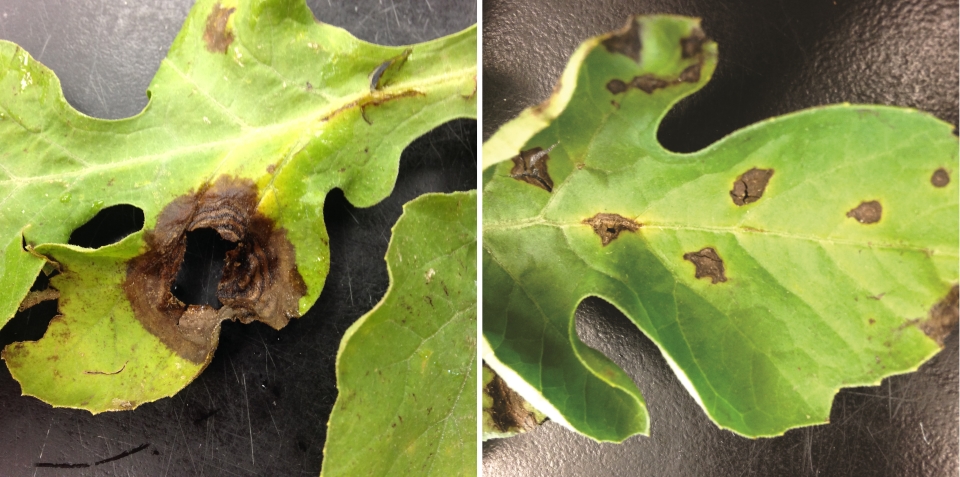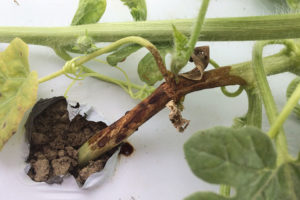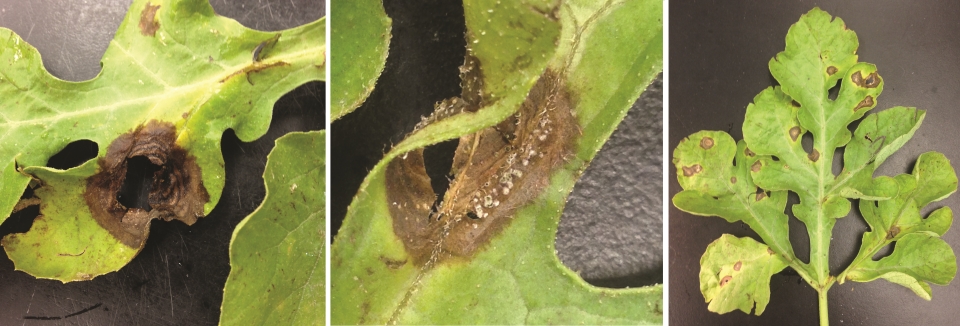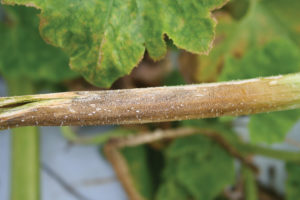Field Scouting Guide: Gummy Stem Blight

Advanced gummy stem blight. Photo by Anthony Keinath.
This month’s Field Scouting Guide concentrates on gummy stem blight. Each month, we bring you a different crop protection issue, ranging from weeds and diseases to insects and even wildlife.
Clemson University’s Professor of Plant Pathology Research and Extension Vegetable Pathologist Anthony P. Keinath, Ph.D., who is highly respected among his peers for his knowledge about this issue, offers his advice on managing this disease.
BASICS
- Scientific name: Stagonosporopsis citrulli; S. caricae; S. cucurbitacearum (formerly Didymella bryoniae and Phoma cucurbitacearum). S. citrulli is the most widespread of the three species.
- Common name: Gummy stem blight. The fruit rot phase has a separate name, black rot.
- Geographical Range: Worldwide, but it is most common in temperate and tropical areas with high rainfall and in greenhouses. In the U.S., gummy stem blight is most common in the Southeast.
- Crops affected: All cucurbits, but cantaloupe, watermelon, and cucumber are more susceptible to gummy stem blight than squashes. Butternut squash, cucumber, and cantaloupe are the cucurbit fruit most susceptible to black rot.
- Need to know: Growers should also note that the gummy stem blight fungi produce two types of spores: moist conidia for short-distance spread during wet weather, and dry ascospores, which are spread by wind.
DISEASE IMPACT
Gummy stem blight is a problem on cucurbits every year in all parts of South Carolina and other Southeastern states. Based on detailed surveys of 46 commercial watermelon fields in spring 2015 and 2016, 45% of the fields had gummy stem blight on more than 50% of the diseased leaves in the field.
The watermelon yield lost to gummy stem blight is estimated to be $2.6 million each year in South Carolina, based on an average loss of 14% of fruit by weight in the spring crop. Yield losses can double in the fall, when long dew periods create very favorable conditions for gummy stem blight. Losses to cantaloupe are estimated to be a similar percentage of the yield.
Gummy stem blight affects cucurbit plants of all ages, but greenhouse-grown seedlings and mature plants are the most susceptible. If the pathogen is present on the seed, on plant debris, or as airborne spores in the greenhouse, symptoms will show up on seedlings with fully expanded cotyledons as the first true leaf is opening. Water-soaking on the hypocotyl below the cotyledons or at the point where the cotyledons attach is a typical symptom. Brown spots also can form on the cotyledons and true leaves.
In the field, gummy stem blight really starts to develop after the vines have spread together and the rows have closed with a thick canopy of leaves that trap moisture on the older leaves inside the canopy. This growth stage is also when fruit start to enlarge.
IDENTIFICATION
Gummy stem blight can be difficult to distinguish from other disease that create spots on leaves. Three diseases are commonly mistaken for gummy stem blight. Here’s a guide on how to distinguish between them.
Anthracnose

A leaf with gummy stem blight (left) next to a leaf with anthracnose (right). Photos by Anthony Keinath.
The most common look-alike cucurbit disease is anthracnose on leaves of watermelon, cucumber, or cantaloupe.

Notice of the wet-looking lesions on the stem. These water-soaking or greasy lesions are a hallmark of gummy stem blight (GSB). Anthracnose, the disease most often confused for GSB, does not have this feature. Photo by Anthony Keinath.
In general, water-soaking or a greasy appearance of lesions on mature plants is more typical with gummy stem blight than anthracnose. Anthracnose causes spindle-shaped, narrow, tan lesions on vines that are absent with gummy stem blight.
Both diseases cause symptoms on petioles, but if the petiole lesion goes completely around the petiole, it is gummy stem blight. Gummy stem blight causes dry, beige, or tan cankers on the main stem of plants, but there are no cankers with anthracnose. Leaf spots of anthracnose tend to be smaller than spots of gummy stem blight, but there is a range of sizes of spots with both diseases.
Target Leaf Spot

A leaf with gummy stem blight (left) next to a leaf with target leaf spot (right). Photos by Anthony Keinath.
In the fall, target leaf spot on cucumber and watermelon could be confused with gummy stem blight, because symptoms of both diseases include leaf spots with target-like rings.
Target leaf spot lesions have light-colored centers and darker edges, while leaf spots of gummy stem blight are uniform in color. Lesions of target leaf spot usually are smaller than leaf spots of gummy stem blight. The centers of older target leaf spot lesions tend to drop out, while this symptom is not common with gummy stem blight.
Crater Rot

A leaf with gummy stem blight (left) next to two leaves with crater rot, also known as ink spot (middle and right). Photos by Anthony Keinath and Gabriel Rennberger.
Another fall disease on watermelon is the leaf blight phase of crater rot, which my former graduate student and I are calling “ink spot,” Keinath says.
Like gummy stem blight on watermelon leaves, ink spot lesions are dark brown, often target-like, and occur at the edges of leaves. Like target leaf spot, ink spot lesions crack, and the centers may drop out.
To reliably identify ink spot, it’s necessary to check for fruiting bodies in the center of leaf spots. Ink spot spores form in several shiny masses that look like drops of olive green to black ink. Gummy stem blight spores form inside dark fruiting bodies that look like small dots to the naked eye or like tiny bumps under a hand lens. They also form on petiole lesions, which are absent with ink spot.
RECOMMENDED TREATMENT
Conventional fungicides are the most effective treatment option. Growers should be aware that the most common species of the gummy stem blight fungi, S. citrulli, is resistant to fungicides with FRAC Codes 1, 7, and 11. In Georgia, S. caricae has reduced sensitivity to fungicides with FRAC Code 3. Growers should be careful not to apply the wrong fungicide, based on the fungicide resistances reported in their states.
Organic growers can use Oso (Certis USA). Its active ingredient, polyoxin zinc sulfate, acts as an antibiotic.
Gummy stem blight needs moisture on the leaves to develop. In a dry season, fungicide sprays can be made every two weeks instead of every week as in a normal or wet season. However, you should continue to spray for powdery mildew, which will be more active in a dry period.
Growers having trouble managing gummy stem blight may not be starting fungicide sprays early enough. To work, fungicides must be applied before leaves are infected, so the first fungicide application should be made when the male flowers appear. Fungicide applications to diseased foliage made later in the season may help limit the size of leaf spots but can’t eliminate spots or stop them from expanding.
CULTURAL MANAGEMENT

One way to reduce gummy stem blight’s ability to spread is to promptly bury crop debris. The black fruiting bodies eject airborne spores that help them spread to healthy tissue. Photo by Virginia B. DuBose.
Prompt burial of cucurbit vines and crop debris is the most important cultural practice to reduce gummy stem blight. The gummy stem blight fungi thrive on freshly killed plant tissue. On the vines, they produce black fruiting bodies that eject airborne spores to help them spread to healthy tissue. Survival of the gummy stem blight fungi is shorter in buried crop debris than in debris left on the surface of the soil or, worse yet, on top of plastic-covered raised beds. Burying debris also prevents spore spread.
Crop rotation is the second most important cultural practice to manage gummy stem blight. The gummy stem blight fungus can remain alive on very small (one-half-inch long) pieces of dead vines buried in soil. Because it takes two years (or longer) for all infested debris to decay, especially crown cankers, it is not safe to plant cucurbits more often than once every three years in the same field.
Transplant only healthy cucurbit seedlings. If gummy stem blight shows up in a tray of cucurbit seedlings, seedlings located close to the diseased seedlings probably are contaminated, even if they look healthy. These seedlings can be transplanted if replacement seedlings cannot be found, but fungicide applications should begin a week after transplanting and continue on a regular schedule all season.










